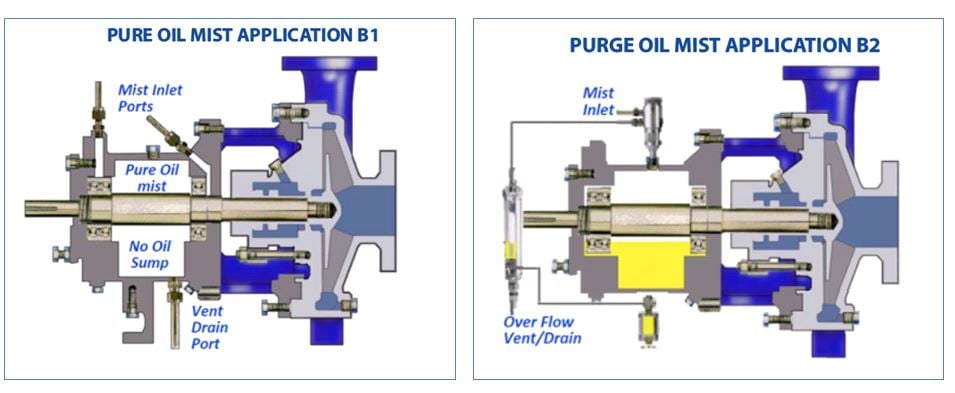


Oil mist lubrication is an advanced centralized lubrication solution comprised of the production and distribution of a continuous flow of atomized Oil particles. These particles are delivered directly to the bearing and metal surfaces, for a high quality, cost-effective lubrication solution.
Oil mist is a mixture of clean, dry Air and Oil (Nebol), a lubricant that is designed to deliver a precise amount of pressurized oil to bearings and metal surfaces, ensuring proper lubrication.
This type of application is specifically designed by DropsA for Oil refineries as it is common that greenfield initiatives for oil refineries specify an oil mist lubrication system for bothpumps and motor bearings.
During the refining process of oil, a process pump, which is used to transfer oil, must be lubricated with Nebol (mist system)that is specifically designed for each refinery. After determining the best position for the Nebol OMG (oil mist generator) the proper amount of oil mist is determined and transferred to the lubrication points.
The oil mist cabinet generator consists of:
- Vortex or Venturi mix header
- Control panel that can communicate with customer’s DCS, communicating alarms
- Heaters for Oil and Air
- Reservoir and upon request, backup units
- EX certified parts
Furthermore, the oil mist system is composed of the following accessories and components:
- Mist manifold: Utilized to evenly divide the mist from the main line. Normally, it is placed above the pumps and can be used to lubricate up to 8 lubrication points.
- Reclassifiers: Lubrication devices used to conjoin and increase the size of oil particles.
- Auxiliary manual pump: In a closed loop system the lubricant must be returned to the main station. A manual pump can help facilitate this process.
Oil mist, which is the mixture of clean, dry air and oil, is generated by an innovative vortex generator. This technology mixes a specific amount of oil from the highest velocity point of the vortex maximizing the acceleration of the particles into the vortex’s center.
At the outlet of the vortex, a rapid decompression zone initially removes large particles by forcing them to coalesce in a static area of the exhaust cone. The remaining aerosol is rotated in a controlled deceleration process in the exhaust cone utilizing the coanda effect accompanied by a specific surface finish used to help further reduce the particle size into sub-micron particles.
A final coalescing plate is used to collect large particles that are subsequently recycled.
The Oil mist lubrication system can be either open or closed loop depending on customer’s requirements. However, in either system It is necessary to calculate the mist flow to each of the lubricating points.
Some points can be PURE, and some can bePURGE. The following diagrams indicate the difference between PURE and PURGE, as shown in the below images.

PURE OIL MIST LUBRICATION
In a Pure Oil Mist application, the oil mist manifolds allow the visual monitoring of the condensed oil as it collects in the drop pipe. This allows the operators to drain the manifold when required.
• Oil Mist Manifold: allows the visual monitoring of the condensed oil as it collects in the drop pipe. This allows the operators to drain the manifold when required.
• Oil Mist Fitting (Reclassifiers): converts small particles of dry mist into larger particles (wet mist) which is used to lubricate surfaces.
• Oil Mist Sight Glass: sight glass allows easy observation of water, or other contaminants, in the bearing housing. Additionally, the sight glass allows venting of oil mist from the closed bearing housing.
• Collection Container:allows the collection of liquid oil from the bearing housing generated from the condensation of oil mist. Allows excess oil to be drained into a separate container.
PURGE OIL MIST LUBRICATION
• Oil Mist Manifold: Allows the visual monitoring of the condensed oil as it collects in the drop pipe. This allows the operators to drain the manifold when required.
• Oil Mist Fitting (Reclassifier): Converts small particles of dry mist into larger particles (wet mist) which is used to create positive pressure inside the bearing housing.
• Oil Mist/Vent/Fill: Allows the Mist to enter the bearing housing while letting it vent at the same time. Also allows filling of oil without disturbing the Oil mist and venting processes.
• Oil Level Sight Indicator: Sight Indicator allows easy observation of the oil level in the pump as well as maintaining the oil level to prevent overfilling of the bearing housing.
• Oil Mist Sight Glass: Sight glass allows easy observation of water, or other contaminants, in the bearing housing.
• Collection container: Allows excess oil from the sight Level Indicator to be drained, maintaining proper oil level inside the bearing housing. Allows excess oil to be drained into a separate container.
An Oil Mist application ensures a series of benefits, such as increasing productivity, reliability, availability, and durability.
By providing the correct amount of lubricant to the proper place, an oil mist lubrication system guarantees the smooth running of mechanical rolling elements, reduced vibration, and lower operating temperatures ensuring reliability and extended life.
Furthermore, it reduces oil consumption resulting in 40% less oil consumed compared to traditional lubrication.
In addition, more than 50% of the lubricant can be recovered. This reduces energy consumption which in turn also reduces the emission of greenhouse gassesinto the environment.